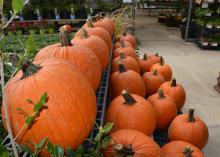Information Possibly Outdated
The information presented on this page was originally released on October 23, 2015. It may not be outdated, but please search our site for more current information. If you plan to quote or reference this information in a publication, please check with the Extension specialist or author before proceeding.
Great pumpkin fields produce timely crops
STARKVILLE, Miss. -- Mississippi pumpkin growers live for conditions like they have seen in 2015.
David Nagel, a horticulturist with the Mississippi State University Extension Service, said for producers to have jack-o-lanterns ready by Halloween, they must plant in early July, when heat and humidity typically contribute to plant disease. Most years, fungal diseases are persistent problems that can significantly reduce yields.
Nagel said the typically challenging seasons often leave growers in serious doubt about planting another pumpkin crop. However, the dry conditions this year made a difference
“This has been one of the best pumpkin years ever,” Nagel said. “A year like this will inspire next year’s growers. Commercial acres have not changed significantly in recent years, and most farmers grow them for agritourism pumpkin patches.”
Nagel said fields had adequate soil moisture at planting time. Many commercial growers have access to irrigation to compensate for the dry conditions throughout most of the growing season.
“Of course, yields are down on the nonirrigated acres, which have fewer and smaller pumpkins,” he said. “But if it had been a wet year with lots of disease pressure, growers would have no pumpkins.”
Nagel said prices were higher last year when diseases reduced yields. This year, with plenty of pumpkins available, prices are closer to the five-year average.
Don Mitchell of Collins said he would not have had any pumpkins this year without irrigation.
“We have had no rain since July 4,” he said. “It’s very tricky growing pumpkins from year to year. We had a total crop failure in 2012 when we got about 20 inches of rain in August and September and just couldn’t overcome that.”
Mitchell Farms, which has grown row crops since the 1960s, added peanuts in the 1970s and vegetables in the 1980s. The family started an agritourism component in 2006 and began growing pumpkins in 2007.
“We are getting better at controlling diseases and such. This is our best pumpkin year ever,” Mitchell said.
Thomas Horgan, a researcher with the Mississippi Agricultural and Forestry Experiment Station, is conducting organic fungicide trials at the MSU North Mississippi Research and Extension Center in Verona. In 2015, organic fungicides performed about as well as the nonorganic options, he said.
“Diseases were not bad, but we had plenty of insect pressure. Squash bugs will wipe you out. They like pumpkins just as much as they like squash, so you have to monitor and stay ahead of them with insecticide treatments,” he said. “It’s also important to harvest as soon as they start turning orange to avoid stem blight.”




